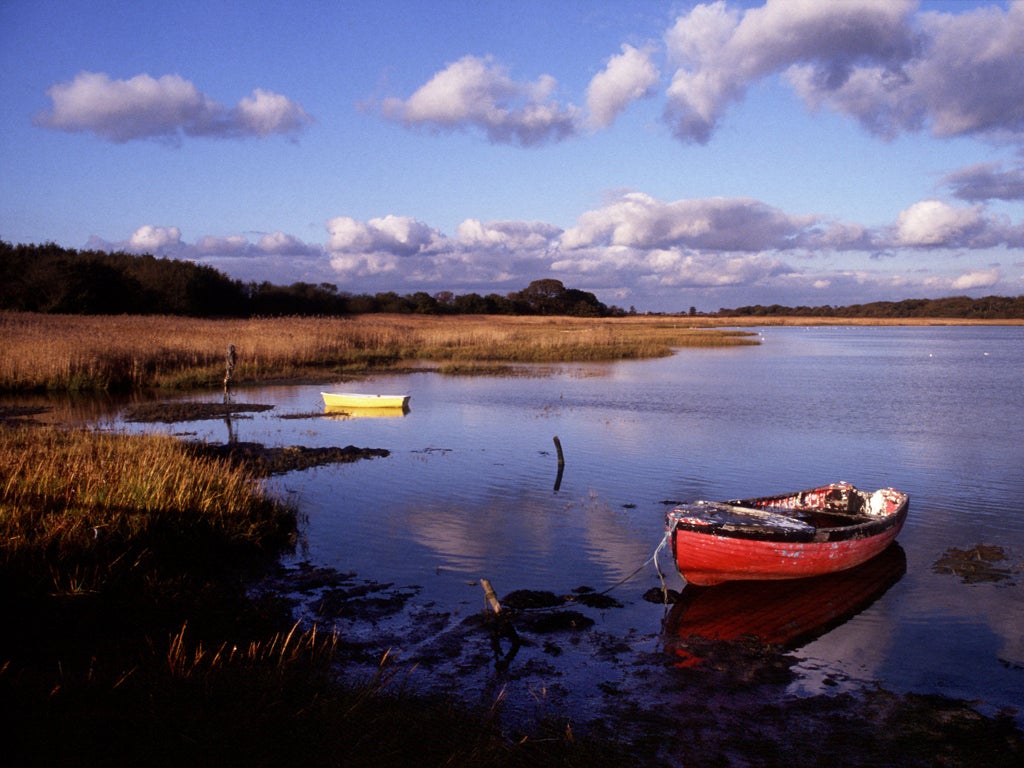As any budding palaeontologist knows, a bucket and spade are handy for more than just building sandcastles on the Isle of Wight.
They are useful for rooting around in the sand along the base of the cliffs at Yaverland, where every rock you pick up seems to contain a fossil. When I visited, the autumnal gales had kicked in, hurling spray and waves at the battered cliffs, loosening the soil and releasing more fossils for hardy amateur collectors.
I'd dropped down to Yaverland beach, north of Sandown, as part of a walk that takes in the rich wildlife and history of a strangely enigmatic easterly point of the island. Starting in Brading, south of Ryde, I was immediately struck by how diligently the island waymarks its paths. Almost all footpath signs come with a number as well as the destination. And so, I dutifully took footpath number SS44 through the Brading Marshes nature reserve.
The landscape is being restored and already teal and widgeon are among the ducks returning, while the rarer snipe – twitchy, mottled brown, long bill – may flutter around in the ditches, and flocks of lapwing should by now have arrived for the winter. The area feels like an island within an island, which until a few hundred years ago was the case, when the Isle of Bembridge was separated from the main island by a tidal channel that now forms the course of the River Yar.
After collecting several modest fossils – 65 million-year-old oyster shells, according to Alex, a passionately knowledgeable guide at the nearby Dinosaur Isle museum – I clambered up the heathland that runs above the beach. Cattle graze randomly here and vigorous clumps of gorse still in flower had colonised the narrow, fractured valleys that lead down to the sea. Out on the Channel, tankers were queuing up to dock at south-coast ports, while windsurfers scuttled along the water in a stiffening breeze.
The top of the climb is marked by Culver Down and the Yarborough Monument, which you could argue form something of an imposition, because on either side there are superb views in all directions – south back towards the hills above Shanklin, the fetching rolling hills of the hinterland, and northwards to Bembridge and Ryde.
I made for the coast path and Bembridge, with useful information boards filling me in on the age and character of the sandstone and chalk cliffs I walked upon. Many of the fossils are freshwater, and date back to a time when the Isle of Wight was closer to modern-day North Africa. Just out to sea, was Bembridge ledge, at low tide its exposed skerries and rock pools resembling a reef. Elsewhere, the sea has taken sizeable chunks out of the cliffs. The coastline around Bembridge – the pebbles make for a rather painstaking plod on the beach – is attractive, too, with woodland groves, now bare of their leaves, acting as a scaffold through which to view the sea.
Beyond Bembridge, striking out into the interior of the island, the landscape changes yet again in the form of Brading Marshes, a silent, open expanse of land that has a touch of a magic about it. Above the marshes stands a lonely 17th-century windmill, the last remaining windmill on the island, but the land then tumbles away to become spirit-level flat, with paths threading through reedbeds and clumps of woodland thick with old oak, ash and hazel and home to buzzards, yellowhammers, red squirrels and the embattled green woodpecker. Gazing down on this enchanting landscape is the chalk edifice of Bembridge Down and the Victorian era Palmerston fort.
Arriving back in Brading, I had time to visit the truly excellent remains of the Roman villa – one of the best, when it comes to interpretation, in the UK. The Romans, I learnt, favoured the east of the island for its more sheltered climate, fertile lands and easy access to the continent. I was particularly struck by a map of the Roman perspective from Wight – the east, and the Isle of Bembridge, are positioned north, and the direction and flow of trade to London, France, the Low Countries and, via the Rhine, to the heartland of Germany – and then Italy – was obvious.
Whether it is fossils, Romans, wildlife or, indeed, the prevailing 1970s bucket-and-spade charm that draws you here, the Isle of Wight is a walking destination for all seasons.
Compact Facts
How to get there
Mark Rowe travelled to the Isle of Wight with Wightlink Green Getaways (0871 376 0013; wightlink.co.uk/ greengetaways), which offers three-night weekend breaks at Niton Barns in the village of Niton from £121 per person, including return Wightlink ferry crossings from Portsmouth or Lymington. Wightlink publishes a free walking brochure, Wight Safaris (wightlink.co.uk/wightsafaris).
Further information
Brading Roman Villa (01983 406223; bradingromanvilla.org.uk)
Dinosaur Isle (01983 404344; dinosaurisle.com)
Directions
OS Map: OL29.
Distance: 9 miles.
Time: Four hours.
Start at Brading railway station. Head for the B3395 (Bembridge Road). Take footpath on right (SS44) across fields and turn left to follow the path in front of houses and down to B3395. Turn right and then left on to beach before walking up the grassy slopes to Culver Down and the Yarborough Monument. Follow coast-path signs – including diversion behind Foreland Fields – to Bembridge and take the beach route around the town. At Bembridge Point take footpath BB33 to Dulcie Avenue and turn right along unpaved road to the T-junction. Turn left, then right up Bembridge high street. At the bend, take the footpath ahead to Bembridge Windmill and follow waymarkers to Brading via Centurion's Copse. Cross railway back to train station.

Join our commenting forum
Join thought-provoking conversations, follow other Independent readers and see their replies
Comments